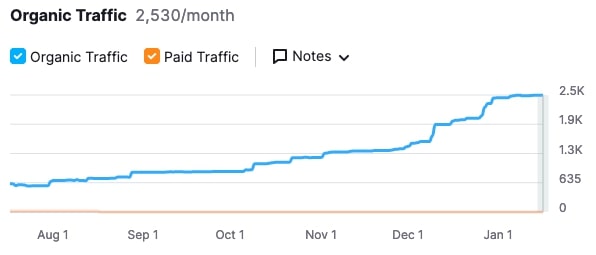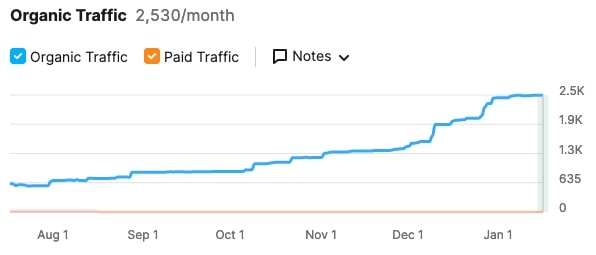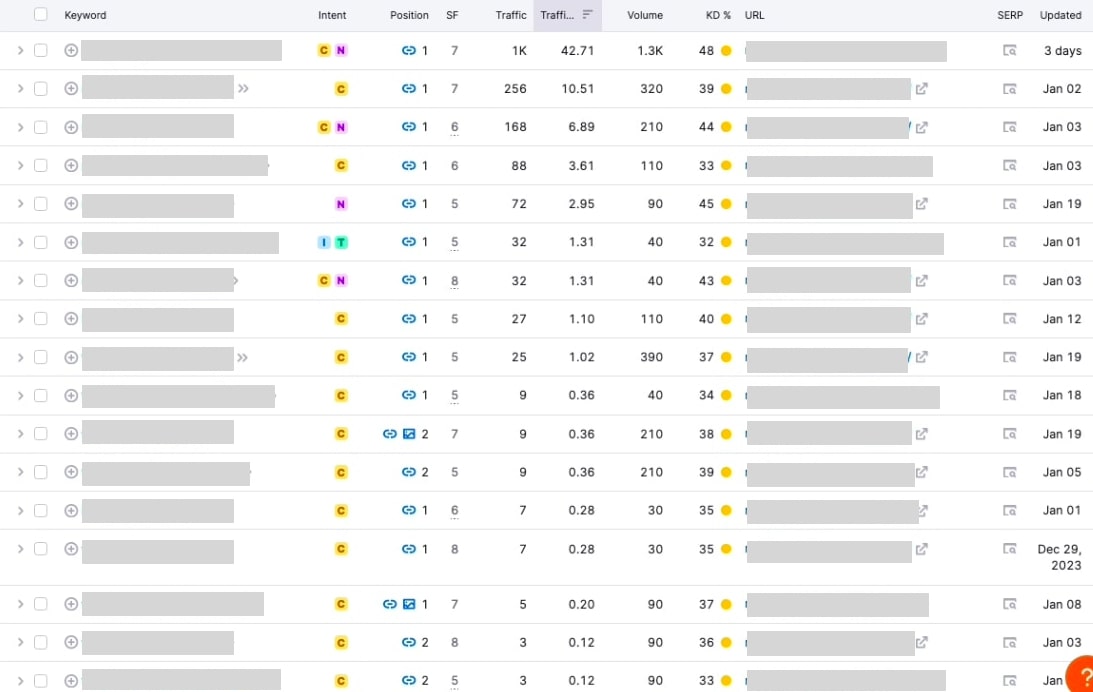Operating within the highly competitive weight loss industry, the client’s website was a labyrinth of missed opportunities plagued by inefficiencies that stifled its potential to attract and engage. The mission was clear: to catapult the website from the shadows of obscurity to the forefront of organic search results. This case study unfolds the journey towards achieving a staggering 151% increase in organic traffic.

Background and Initial Analysis
For this project, we focused on a unique approach that shot organic traffic up by 151%. It started with understanding our audience deeply.
It started with understanding our audience deeply, particularly those seeking weight loss solutions, and how they searched online. Our analysis didn’t stop at surface-level trends. It dug into the why behind user behaviors specific to weight loss interests. We used tools like SEMRush to track keywords gaining traction and saw shifts in interest over the months.
Also, monitoring competitor activities showed us gaps in their approaches that we could exploit. Such insights led to the significant refining of our content plan. By focusing on these areas without initially diving deep into technical SEO improvements or structural website changes, we laid the groundwork based entirely on user needs and market demands.
Technical SEO Audit
First, we checked the website’s speed and whether the pages were indexed properly. It was vital to ensure URL health and that all images loaded without issues.
A well-functioning site is key for top Google rankings. Luckily, this client’s site was mostly up to mark. However, broken URLs were an issue. They hurt both user experience and search engine ratings, which is critical in an industry where users seek reliable and quick information on weight loss. Fixing these quickly became a priority.
Next was the sitemap, a roadmap for search engines to understand our site better. It had errors, too. Some parts of it were outdated or wrong which could mislead search engines about our content’s structure making new page discovery harder than necessary.
After sorting these foundations out, I focused on what draws people in: content based on thorough keyword research to plug directly into what potential visitors sought from the site.
Assessing Website Structure and Identifying Inefficiencies
In tackling the site’s layout, we identified key flaws. The client’s main issue was traffic, which mostly hit their homepage rather than deep pages fitting specific keywords related to weight loss. A close look showed that while many terms ranked well, essential content spreading was missing.
Competitors outdid us by dedicating unique pages for similar keywords. Our solution didn’t need new keyword hunting but a smarter alignment of existing ones across the website’s structure. We noticed an over-concentration of relevant links pointing back to just the homepage despite having dedicated landing pages. This misdirection caused its lower-than-desired ranking.
We reshaped internal linking strategies and content distribution to distribute online visibility more evenly. Transferring Homepage contents to service-specific pages ensured better flow and relevance among linked topics. This reorganized approach allowed deeper pages not only to surface higher on search results but also helped balance how potential clients discovered varied offerings without overwhelming them with information solely through the initial landing page.
Strategic Restructuring and Organization
We realized early on that simply tweaking bits here and there wouldn’t cut it. We needed to rethink our approach from the ground up, focusing on what truly mattered: clear, engaging content paired with an intuitive site layout.
We scrutinized every page, asking if they served our reader’s needs while making sure navigation was a breeze. Pages cluttered with outdated information were overhauled or removed entirely; we wanted no dead ends in this digital maze of ours.
Keywords played a vital role too but not in the old spammy way. Instead, research showed us exactly where natural inclusion could drive both relevance and engagement without sacrificing readability or value for readers like you who sought answers.
Lastly, responsiveness across devices became non-negotiable with more people browsing on the go than ever before, ensuring quick loading times regardless of the device used made all the difference.
Enhancing Internal Linking Structure
We looked at our client’s site and saw a big issue with how we link things. The page we want people to see when they search for the target keyword is hard to find. Only one out of four links went there, leaving it stuck below top spots on search pages.
Our main page gets all the attention, which isn’t great as others dominate the prime spots online in the weight loss category. Here’s what we did: we didn’t hunt for new keywords since our ranking wasn’t bad. Instead, we moved the key page up in importance on our site by linking more stuff directly to it from related offerings and putting them under clear categories.
Crafting a User-Centric Linking Architecture
We dove deep into the heart of our website’s issues, starting with a tool that combed every page. It was like sending out an expert detective to uncover what went wrong in the digital world we built. This process unearthed broken links and confusing paths that likely made visitors leave in frustration.
A major problem we found was how these roadblocks weren’t just annoying. They hurt our site’s standing on search engines. Fixing them became our top priority. Together with SEMRUSH insights, we learned where content fell short for both users and their searches.
Our strategy had multiple parts: First, clean up anything slowing us down or turning people away, like those complex URLs and duplicate pages stuffed with keywords but not value.
Next came enhancing readability while ensuring images contributed to this clarity. Each picture now carried a clear description if someone couldn’t see it directly. Then, it was time for organization. Making sense of chaos meant rethinking navigation from scratch so anyone could find exactly what they needed without guesswork, especially when it came to weight loss information.
Strategic Content Optimization
We began by tackling broken URLs and sitemap issues to ensure search engines could easily navigate our site. This groundwork allowed us to focus on crafting the right content.
Our journey started with thorough keyword research using tools like SEMRush. Understanding what our audience seeks was crucial. It guided us towards relevant topics. We strategically planned articles employing the Skyscraper Technique for depth alongside shorter pieces for variety.
Additionally, we revisited existing articles, enhancing them with visuals or updated information to better meet current search demands. Optimizing these along with fresh content significantly contributed to attracting more visitors through improved Google rankings.
Backlink Auditing
For this project, we found their link profile messy and filled with low-quality links from irrelevant domains. We tackled this by making steady changes to the files that we disavow each month through Google Search Console.
This strategy allowed us to clear out harmful links that were dragging down the site’s reputation. We focused on ensuring the main pages were a mere three clicks from the homepage because easily accessible content ranks better and draws in more visitors effectively. Another crucial step was evaluating anchor text diversity within incoming links.
Our aim was for a natural mix, including exact match, partial match, branded, and generic types. With meticulous work overtime to filter out toxic connections while valuing high-quality ones based on keyword visibility and organic traffic contributions. It wasn’t just about cleaning up but also optimizing future growth pathways.

The Result: 151% Increase in Organic Traffic
The most significant achievement of this campaign was the impressive 151% increase in organic traffic. By optimizing meta tags and content readability and ensuring the website’s structure was conducive to user navigation, the site’s visibility in search engine results pages improved markedly.

Future Strategies for Growth
Our focus has been on delivering top-notch SEO results for our clients in the weight loss industry. Now, with a solid readership foundation and the website streamlined to only feature high-value posts, it’s time to scale up further.
The next steps involve deepening our keyword strategy by pinpointing not just popular terms but also long-tail phrases that speak directly to our audience’s needs. We plan to continue refining each blog post, making sure every piece of content is detailed. This approach aims to maintain engagement while boosting search relevance through comprehensive coverage of topics.
Another key tactic includes revisiting unpublished drafts stored in WordPress, evaluating them for potential updates or integration into existing successful content assets, followed by strategic internal linking based on nuanced keyword research from within the dashboard itself. Every step taken will adhere strictly to ensuring authenticity and providing genuine value, a principle rooted deeply since witnessing initial dramatic traffic boosts thanks partly to lessons learned along my journey in improving organic reach significantly beyond expectations.
Our work on this project shows that boosting organic traffic is possible with the right steps. We started small, focused on quality content and smart keywords. Over time, our efforts paid off in a big way. We saw more people visit the site without paid ads.
This success story proves that understanding your audience and using good SEO practices can lead to great results. Let’s keep learning from such examples to grow our online presence even more in the future.









